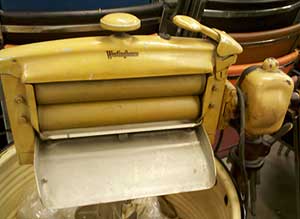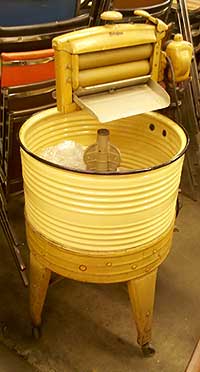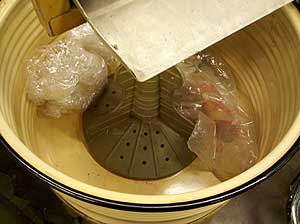The man made the statement in jest, but it was oh-so-true.
“This was when women had it tough,” he said to the two other people with him. He was walking towards a lovely yellow vintage wringer washing machine that from a distance looked like it had not been used often. He touched the wringer, seemingly amazed and enamored with this wash-day anachronism. “Can you believe that,” he said. “I’ll be darned.”

I had spotted the machine about five minutes before he approached it, and I was also taken by its look. It stood out among the disparate collection of powered wheelchairs and small tables at the auction house. We both knew it was a source of labor for women who had to carefully guide wet clothes through it without losing their fingers or any other body part. The man obviously came from a home where mothers, grandmothers and aunts did the laundry and not the family maid (as evidenced in the movie “The Help,” where they cooked, cleaned, washed, ironed and raised the babies).
From where I stood, the Westinghouse machine appeared to be clean on the outside and inside, and its metal agitator was still intact in the tub. As I rounded it for a more thorough look, I saw telltale signs that it had worked hard: Thick grease and dirt had darkened the electric motor on the left side.
Intrigued, I went searching for more information on this metal contraption built to do “woman’s work” and came across a fascinating bit of history buried deep in Google:
A black woman named Ellen F. Eglin of Washington, DC, invented what some sites described as a successful clothes wringer in the 1880s. She never benefited, though, because she didn’t patent it. Instead, she sold her design to an agent for $18. She said in Woman Inventor magazine in 1890 that she sold it for one reason: “You know I am black and if it was known that a Negro woman patented the invention, white ladies would not buy the wringer. I was afraid to be known because of my color in having it introduced into the market.”

Not much is known about Eglin. She was born in 1849, and worked as a housekeeper for a time – that’s probably where she got the idea for the wringer, to help relieve herself of the tough work. She was a member of the Women’s National Industrial League – a female labor union headed by Charlotte Smith (who founded Woman Inventor magazine) – and worked as a federal clerk in the Treasury Department and the Census Bureau, according to the 1995 book “Mothers and Daughters of Invention” by Autumn Stanley.
Eglin apparently was working on another invention in the 1890s that she had planned to show off at the Women’s International Industrial Inventors Congress. Other sites I came across mentioned that the first clothes wringer was added to machines around 1861, and none of them mentioned Eglin’s device. So, I’m not sure if she invented the wringer or developed her own version.
Before 1900, washing machines were cranked by hand, and the first electric-powered machines were sold around 1908. It would be after World War II before the first top -loading automatic machines were manufactured. A collector of vintage washing machines has corralled his finds in a museum in Eaton, CO, called the Lee Maxwell Washing Machine Museum. It has 400 machines, including some early wooden ones, according to the museum website.
The website noted that the Nineteen Hundred Corp. (which later became Whirlpool) promoted its powered machine with a label on the side of the wringer that said “Saves Women’s Lives.” Then there was the Women’s Friend Machine designed to lessen the amount of time to do laundry.

This very practical and useful device could also be dangerous to fingers, hands, breasts, hair and clothes. A report from the 1960s out of Chicago talked about the seriousness of the injuries caused by things getting caught between the rollers, including the clothes of a 4-year-old who choked to death.
I wasn’t around when the machine sold but one auction-regular said that it went for $80-$90. I wondered how it would be used; perhaps sitting in a store, my auction buddy Janet suggested. It would certainly be a conversation-starter.
